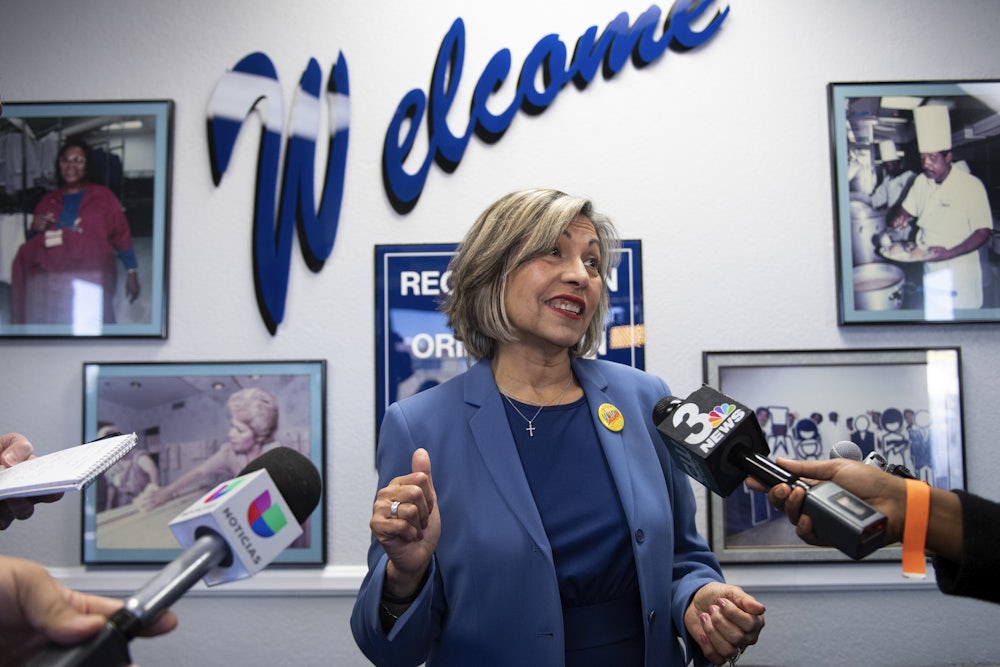The Culinary Workers Union, Local 226 of Unite Here, in Las Vegas, is the most successful private-sector union local in America. During the past three decades, as union membership dwindled nationally, the Culinary Workers tripled its membership. It has won contract guarantees for hotel housekeepers to work 40-hour weeks when nonunion housekeepers more typically work 25- or 30-hour weeks. It’s built a health care plan with no monthly premium and no deductible. And it’s “catapulted thousands of dishwashers, waiters, and hotel housekeepers into the middle class, even though those are poverty-level jobs in many other cities,” according to Steven Greenhouse’s authoritative 2019 book, Beaten Down, Worked Up: The Past, Present, and Future of American Labor.
The leader of the Culinary Workers during the past decade, secretary-treasurer Geoconda Argüello-Kline, announced her retirement earlier this month after 32 years working for the union and nearly 40 as a member. (She joined in 1983 while working as a guest-room attendant at what is today the D Las Vegas Casino Hotel.) I spoke with Argüello-Kline via Zoom earlier this week.
“I have great memories from this group,” said Argüello-Kline, in heavily accented English. (Born in Manuagua, Nicaragua, she emigrated to the United States in 1979.) “I was with the Frontier strikers. I was the lead organizer.”
The Frontier strike, which began in 1991, was a landmark event in recent labor history, which has not accumulated many others. Formerly owned by Howard Hughes, the Frontier was a once-lavish casino hotel on the Las Vegas Strip that had been scaled down into a destination for budget gamblers. Among the new owners’ many economy moves was a halt in contributions to the Culinary Workers’ pension fund and the initiation of new work rules that violated the union contract. The Culinary Workers and three other unions struck in September 1991. It would be more than six years before they returned to their jobs.
It was one of the longest walkouts in the history of the U.S. labor movement. “No one crossed the picket line in six years, four months, 10 days,” Argüello-Kline recalled. “People kept fighting.” The economic pressure that Argüello-Kline and her cohorts brought to bear eventually persuaded the owners to sell, and their successor restored pension and seniority benefits.
The most stunning part of the Culinary Workers’ success story is that it’s unfolded in a right-to-work state. A right-to-work state is one where labor unions are legally barred from requiring union nonmembers within a given bargaining unit to pay a fee to cover the nonmembers’ portion of collective bargaining costs. The prohibition, which exists in 28 states, is a free-rider strategy to bleed union treasuries dry. It’s one of several provisions in the anti-labor 1947 Taft-Hartley Act that, over successive decades, proved remarkably successful in diminishing the size and power of organized labor in the U.S.
Nevada passed its right-to-work law in 1952, just five years after Taft-Hartley, in large part to shut down the Culinary Workers Union. Las Vegas was just taking off as a national tourist destination in 1948 when the city’s bartenders went out on strike. The hotel and casino owners retaliated by getting the state’s voters to approve a right-to-work initiative. But it didn’t break the Culinary Workers. They just worked that much harder to keep the rank and file loyal.
“We know we live in a right-to-work state,” Argüello-Kline said, but the key to advancing workers’ interests has “always been organizing. That’s our normal way.” But succeeding in a right-to-work state requires an unusual degree of loyalty from rank-and-file workers (who, if they don’t join the union, can save a lot of money and still enjoy the benefits of representation). How did the Culinary Workers achieve that? Argüello-Kline credits the persuasiveness of the union’s shop stewards. “You have to have a high, high membership,” she explained. About 97 percent of the Culinary Workers’ bargaining units, she said, join the union.
One clear strength is the union leadership’s diversity, from Argüello-Kline on down. The union’s membership hails from 178 different countries and speaks 40 languages, according to its website. About 55 percent of its members are women, and roughly the same percentage are Latino. Eighteen percent are white, 15 percent are Asian, and 12 percent are Black. Argüello-Kline’s spoken English is very much that of a first-generation immigrant, and during our interview I struggled sometimes to understand what she was saying. That made me wonder how she had succeeded so well in a job that required strong communication skills. Eventually I concluded that in a majority-Latino union, it probably mattered a lot more that she converse easily and fluently with her many Spanish-speaking members.
The Culinary Workers’ parent union, Unite Here, was created in 2004 by the merger of the Union of Needletrades, Industrial, and Textile Employees (i.e., UNITE) with the Hotel Employees and Restaurant Employees Union (i.e., HERE). Well before the merger took place, Argüello-Kline said, its constituent parts led the labor movement in promoting immigrant rights. Although it’s hard to remember now, the U.S. labor movement was anti-immigration well into the 1980s to protect the interests of native-born workers. Even Cesar Chavez, the Chicano leader of the United Farm Workers, favored strict limits on immigration from Mexico and referred casually to those workers who arrived illegally as “wetbacks.”
During the Covid-19 pandemic, the Culinary Workers pressed the state legislature to make Nevada the first (and thus far only) state to enact mandatory protections for hotel workers. These included, for the workers, daily temperature checks, mandatory Covid testing, mandatory masks, and mandatory social distancing of six feet from guests. In exchange, the state granted broad liability protection to employers. The Culinary Workers also got the legislature to pass, in March 2021, a bill requiring hotels, casinos, stadiums, and travel companies to give all laid-off workers the opportunity to return to work. Argüello-Kline told me more than 80 percent of union members have done so.
Did the union back a vaccine mandate? Argüello-Kline said the union strongly supported vaccination, but when I asked whether the union specifically endorsed a vaccine-or-weekly testing mandate akin to the Occupational Safety and Health Administration’s (now struck down by the Supreme Court), she begged off. “We’re not the employers,” she said. “Whatever the employers say. But they have to talk to the union.”
The big question is whether the Culinary Workers’ success story can be replicated elsewhere. In Beaten Down, Worked Up, Greenhouse notes that it enjoys a few advantages.
Las Vegas is in ways a hothouse, with its gaming and hospitality industry expanding rapidly in recent decades, helping fuel the Culinary’s growth.… Moreover, many casino-hotels are highly profitable, and that enables them to afford generous pay and benefits. And the Culinary has unusual leverage over the hotels because they are so image conscious and vulnerable to political pressure (as well as embarrassment from strikes and picketing).
Even so, Greenhouse concludes, the Culinary Workers’ example should inspire other unions to “be more aggressive about organizing, be smarter about using research and political influence, and do a lot more to involve and mobilize their members.”
“It’s like a marriage,” Argüello-Kline explained. “You have to work with the company. You have to have [a] relationship with the company. Some companies, they understand better this situation, and some companies, they fight back, and some companies, they never will understand the situation, and that’s when you come to be like a divorce.… The members know, when you go into a fight, you know when you go into the fight, but they know they have to keep it solid until the end. You never know when you’re gonna say you’re finished.”










